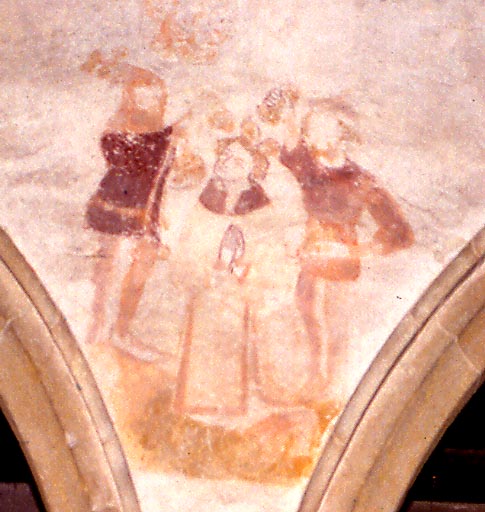Catfield, Norfolk (†Norwich) C.14
The Stoning of St Stephen

This painting is rather later than the example of the subject at Black Bourton and like the other paintings in the church it has been dated to around 1377. Stephen, kneeling in prayer and facing us, is correctly vested as a deacon of the church. His appropriate robe, the dalmatic, shows quite well here.
His tormentors wear the dress of the day; tight hose and the very short tunic which appealed to fashionable young men, shoes with exaggerated points. The man on the left seems to be wearing a hood with a liripipe which would normally dangle down his back. Alternatively this may be the kind of ‘comedy’ hat sometimes seen on torturers of Christ or the Saints.
Considerations of space (the church was once very fully painted) mean that the three figures are crowded together in a way that robs the drama of the stoning of some of its impact, giving the impression that the two men are simply piling stones on Stephen’s head (two are already there) rather than throwing them at him. There may once have been other stoners behind, but I think the patch of pigment at the upper left is more likely to have been an angel waiting to receive the martyr’s soul. But apart from that, the painting is faithful to the description of the event in Acts 7:55-60. This and the painting at Black Bourton are the only examples of the subject in the English parish church that I know of, but there may be more.
Of the other paintings at Catfield, one of someone apparently lying in bed, which MR James thought might belong to a ‘Seven Sacraments’ might actually be part of a Seven Works of Mercy – a favourite subject in this part of north Norfolk. It is on the north wall and there is something else there which I think may be the remains of a Passion Cycle. A large Wheel, visible in humid weather at the west end of the north wall, may be a Wheel of the Virtues, and thus a companion to the Tree of the Deadly Sins recorded as here once. On the south wall is a battered painting which has been identified as the Life of John the Baptist, but it seems to me much more likely to be the Martyrdom of John the Evangelist – the one clear detail is certainly a man stoking a fire under a cauldron, presumably preparatory to boiling John in it. Other recorded subjects are St Lawrence (found generally in art as a companion to Stephen) and St Catherine of Alexandria. All these would be appropriate for a church dedicated to All Saints.
There is also a fine painted screen, with sixteen royal saints including an East Anglian favourite, St Olaf.